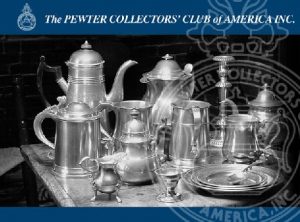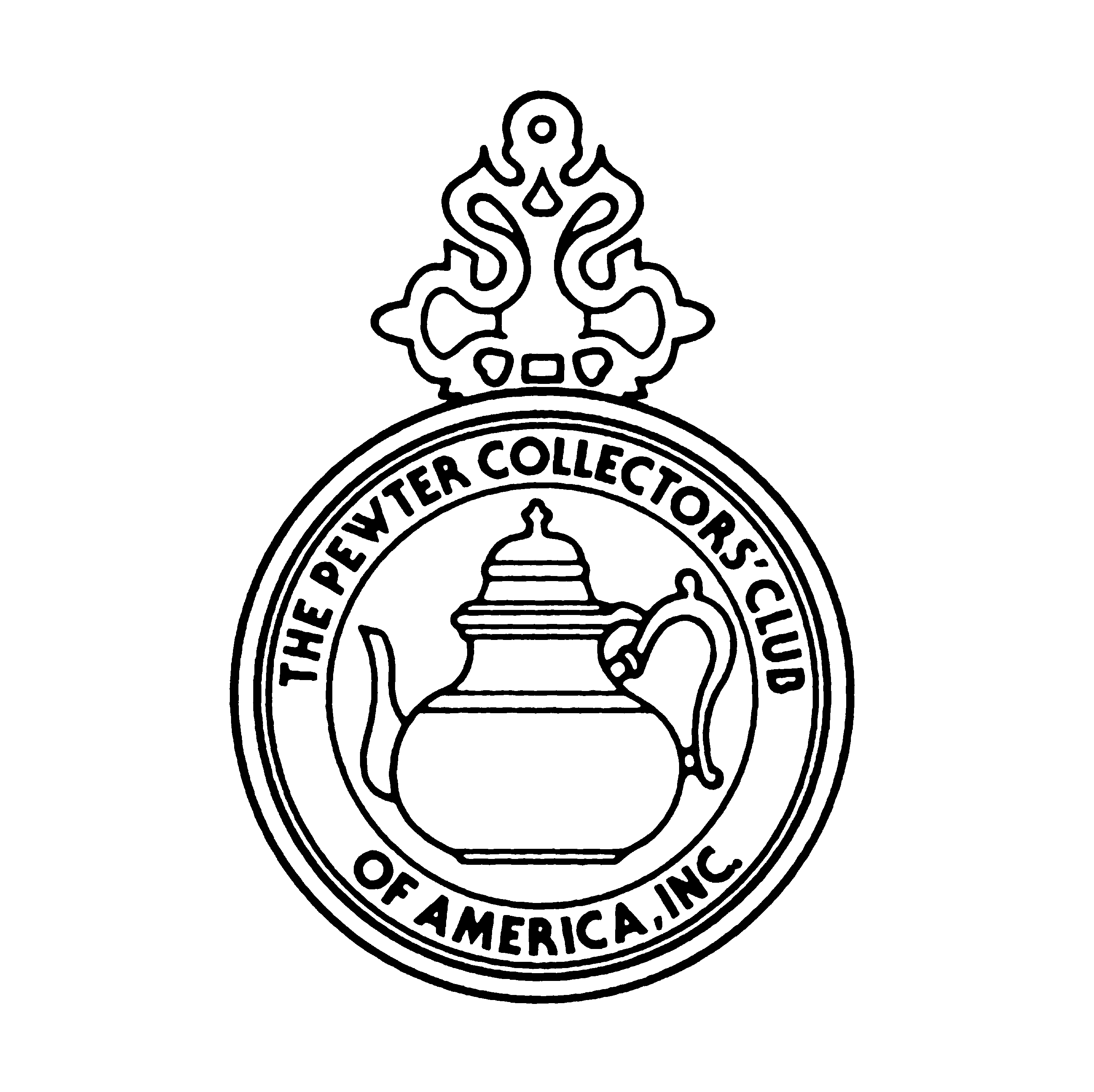An Introduction to Pewter Marks
It has been estimated that one third of American pewter pieces were never marked. Nevertheless, the experienced collector will know by certain design features, details of workmanship, and characteristics of the alloy that some pieces are, or are not, American. The new collector, however, must depend upon pewter marks to help determine the nationality of a piece of pewter. The following is an introduction to the types of marks that may be found on American pewter. Marked examples have been found by only about three hundred American pewterers.
Marks on American Pewter
American pewter may carry one or more of the following types of marks: Pewterers' Marks, Verification Marks, Ownership Marks, and Merchants’ Marks.
Pewterer's Marks
Pewterers' marks fall into five broad categories: touch marks, hallmarks, quality marks, labels and catalogue numbers. Below is an example of the marks of a pewterer who used three of these types of marks (touch mark, hallmark, and a label or place mark). Note that Nathaniel Austin's working period was from 1763 to 1800 and that he used both a pre-Revolutionary, "Lion-in-Gataeway", touchmark and a post-Revolutionary, "Eagle", touchmark.
 |
 |
 |
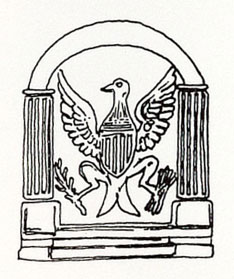 |
For American pewter, the best guide to photographs of pewterers' marks is Ledlie Laughlin's three volumn, Pewter in America, Its Makers and Their Marks. However the last volume was published in 1971. Discoveries since 1971 have been published in the PCCA Bulletin, published twice a year. Other sources for drawings of most of the American pewter marks are listed in the bibliography.
Touch Marks
A touch mark is a pewterer's "trade mark" and in American pewter almost always includes the name or initials of the pewterer. Unlike in London and Edinburgh where guilds regulated the trade, there were no American touch plates where the touch marks of pewterers were recorded. Touch marks vary in both size and style but there are some regional characteristics. And as shown in the touch marks of Nathaniel Austin above, touch marks used prior to the American Revolution tend to show English influence, while those used afterwards often include the American Eagle. After about 1825 the originality of the decorative touches declined radically to simply the pewterer's name in a line form, with some in a rectangular frame.
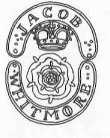 Jacob Whitmore
Middletown, CT, 1758 - 90
Jacob Whitmore
Middletown, CT, 1758 - 90 |
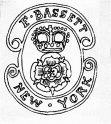 Frederick Bassett
New York City, 1761 - 80
Frederick Bassett
New York City, 1761 - 80 |
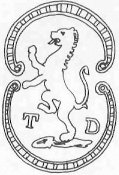 Thomas Danforth II
Middletown, CT, 1755 - 82
Thomas Danforth II
Middletown, CT, 1755 - 82 |
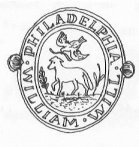 William Will
Philadelphia, PA, 1764 - 98
William Will
Philadelphia, PA, 1764 - 98 |
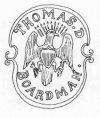 Thomas D. Boardman
Hartford, CT, 1805 - 70
Thomas D. Boardman
Hartford, CT, 1805 - 70 |
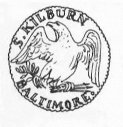 Samuel Kilbourn
Baltimore, MD, 1814 - 39
Samuel Kilbourn
Baltimore, MD, 1814 - 39 |
 Leonard, Reed and Barton
Taunton, MA, 1835 - 40
Leonard, Reed and Barton
Taunton, MA, 1835 - 40 |
Hallmarks
Sometimes called pseudo-hallmarks because they resemble the hallmarks found on silver, these marks often were used with the larger touchmarks or in place of them. For the few 17th century American pewterers that have been identified, hallmarks are the only marks that have been found.
 John Baker
Boston, MA, 1674 - 96
John Baker
Boston, MA, 1674 - 96 |
 David Melville
Newport, RI, 1776 - 93
David Melville
Newport, RI, 1776 - 93 |
Quality Marks
The crowned rose was used in England on pewter from the mid 16th century to denote quality. When used in this country it was most often incorporated into the pewterer's touch mark along with his name. The crowned "X" mark was also used by some American pewterers to "imply" quality. None of these quality marks had any regulatory standing or enforcement.

William Will Philadelphia, PA, 1764 - 98 |
Labels and Cartouches
Some scroll-like labels called cartouches contain the pewterer's name, however most labels found on American pewter are place names, i.e., the name of the city where the pewterer worked. A few marked their pewter with a "London" mark to either deceive their customers or at least imply that their pewter was up to London standards, considered the highest. Only two, Samuel Hamlin, Sr. and Henry Will marked their pewter "Super Fine Hardmetal" or Hardmetal", labels used extensively to designate a quality alloy by London pewterers, many of whom exported to America.
 Johann Christopher Heyne
Lancaster, PA, 1756 - 80
Johann Christopher Heyne
Lancaster, PA, 1756 - 80 |
 Robert Bonyge
Boston, MA, 1731 - 63
Robert Bonyge
Boston, MA, 1731 - 63 |
 Henry Will
NYCity & Albany, 1761 - 93
Henry Will
NYCity & Albany, 1761 - 93 |
Catalog Numbers
In the 19th and 20th century pewterers often produced catalogs of their wares and put the catalog numbers on the articles themselves. They are normally simple stamped numbers of three, four or five digits, sometimes with a letter as well. They are most common on wares made of Britannia metal.
Verification Marks
Verification marks on American pewter are rare because American made measures are rare with the exception of the 19th century measures made by the Boardmans of Hartford, CT. American verification marks, however, can be found on English export baluster measures. These marks are simply letters, indicating the state, commonwealth, or county in which they were inspected, verified and used. These letters most often were stamped on the lids of baluster measures or on the upper rim of the body. Examples are: "A" (for Amsterdam) in New York state, "CM" for Commonwealth of Massachusetts, and "CP" for Commonwealth of Pennsylvania. Unlike in England where verification marks can be found on pub or tavern mugs, such marks are extremely rare on American mugs.
Ownership Marks
Owners often had their initials applied by the pewterer, particularly on sadware. Often it will consist of two or three initials in a straight line; occasionally they will appear in a triad, the center, higher initial being the surname and the other two the forenames of the husband and wife. Some 18th century pewterers owned unique sets of crowned initial marks, distinctive enough to serve as a means of identifying the pewterer. Church pewter is often found engraved with the name of the church.
Merchant's Marks
Some merchants had marks that are as elaborate as touchmarks. There is some evidence that these marks were applied by the pewterer that made the piece. Examples of these merchants are believed to be: Blakeslee Barns, H.N. Rust, and Spencer Stafford, all at one time thought to be pewterers.
Illustrations of marks were taken from Collecting American Pewter, by Katherine Ebert. The marks used from Collecting American Pewter were originally drawn for that book by Mr. Sheridan P. Barnard.
Explore Our Site
For additional information on the PCCA and on American Pewter, including a brief history, a glossary, an excellent comprehensive bibliography and much more, explore our site. Click on "About Pewter" at the top or the "Resources & Links" for additional links of interest..
